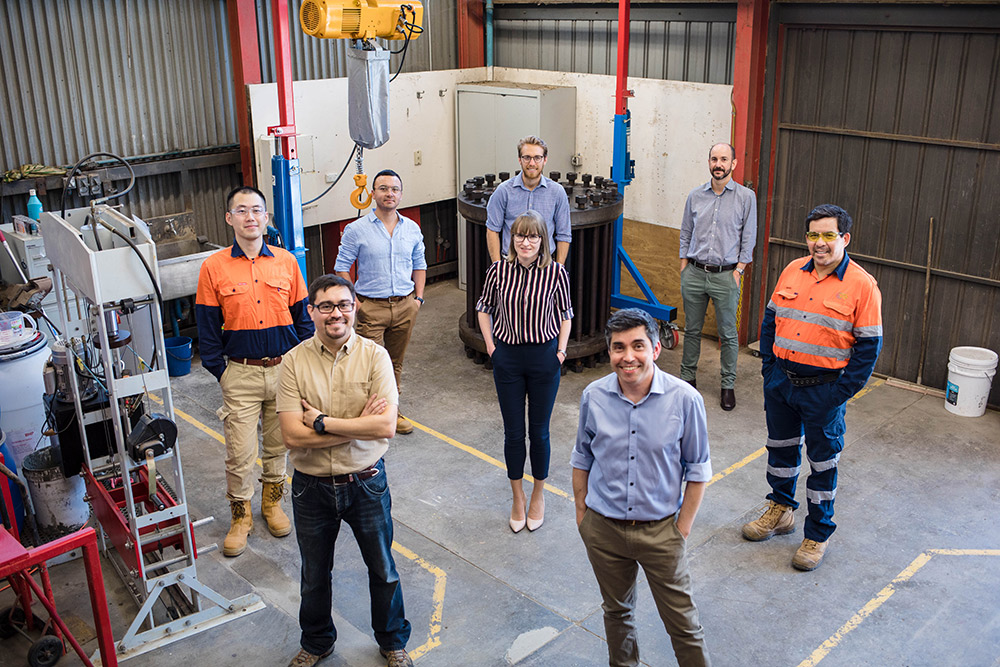Research capabilities
UQ has considerable experience across a number of key capabilities in Future Autonomous Systems and Technologies.
Mechatronics, automation and mission planning
Our team undertakes research into autonomous systems with a particular emphasis on control systems, mission planning, environment perception, and human machine interaction.
We coordinate multiple projects that focus on addressing gaps associated with control strategies that enable automated machines to operate interdependently with other equipment, both manned and automated, in semi-structured environments; optimization algorithms that find the most efficient way to break a high level task description into a detailed action plan; situational awareness capabilities that are able to replace the many and varied functions performed by human operators; and perception capabilities that include challenges such as sensor registration - the ability to estimate and/or verify the pose of a perception sensor relative to a navigation solution; the ability to track and/or verify the joint space and configuration of a robotic manipulator and sensor behaviour in adverse environments - understanding how and why sensors behave when subject to atmospheric particulates such as dust and fog.
Key researchers
Digital rock physics and advanced computational modelling

Our team combines microtomographic imaging with advanced numerical algorithms to create, examine and rapidly test rock samples from the field in a computational environment.
This ‘Digital Rock Physics’ lab can be used in conjunction with our physical testing capabilities to gain a deep understanding of the processes associated with the transport (permeability, conductivity), composition and effective mechanical properties of solid materials.
To realise the flow potential through scanned rock samples a multi-CPU/GPU lattice Boltzmann framework (TCLB) is leveraged along with the parallel computing facilities at the National Computational Infrastructure and the Pawsey Supercomputing Centre.
In addition, the team also has unique computational modelling capabilities in detonation, fracture, fragmentation and the bulk material movement associated with rock blasting techniques. Future applications are focused on disruptive technologies that will enhance both the efficiency and sustainability of mineral extraction as we move towards a low carbon economy.
Key researchers
Geomechanics and applied energetics
Our team has coordinated a range of projects involving both fundamental and applied research in geomechanics and energetic materials applied to all stages of the extraction of mineral and energy resources.
Our expertise spans across multi-physics, multiphase and multi-scales by integrating experimental, analytical and numerical methods.
We are focussing on challenges such as liquid-gas flow in fractured geomaterials, fluids flow in nanopores and microfluidics at both laboratory scale and through complex fracture networks.
In the area of applied energetics, our focus is on detonation physics, new explosive formulations, explosive-rock interaction modelling and enhancing our predictive capability of fracture, preconditioning and fragmentation of geomaterials.
We have access to a state-of-the-art sample preparation facility including a diamond wire saw for dry cutting soft and moisture-sensitive geomaterials; in addition to a range of conventional rock mechanics testing facilities.
More importantly, the team has also invested in unique testing systems that include a multifunctional triaxial permeability rig (up to 10,000 psi pressure range), an acoustic emission (AE) system as well as the only explosive induced preconditioning testing apparatus in Australia that allows controlled fracturing under confinement of large cylindrical samples (up to 800mm in diameter).
Key researchers
Systems simulation and virtual reality
Our team has experience in systems simulation focussing on the complete value chain of a mining operation.
Working collaboratively with industry the team is involved in visualisation and simulation projects associated with the efficient implementation of current and novel mining systems; including the identification of key barriers and processes.
Supporting the group is a 180 degree Immersive Learning Facility (ILF) located in our Advanced Engineering Building.
A large number of Virtual Reality simulations in mining have been developed in the aeras of training, education, visualisation, risk assessment, accident reconstruction and monitoring.
Key researchers
Sensing, systems safety and reliability
Sensing technology has multiple benefits in a wide range of engineering applications, our team has for a number of years specialised in the development and application of fibre opting sensing technology initially focussing on complex underground ventilation problems but now addressing other geotechnical monitoring challenges. The team has a state of the art fibre optic sensing laboratory that supports a wide range of research projects.
Our systems safety capabilities extend to quantitative risk analysis and the design, construction and commissioning of safety test equipment, one of our current projects aim to design, develop and commission a tyre handling test rig to measure the factor of safety when lifting large off-road tyres. In the area of reliability we focus on quantitative risk analysis and evidence-based inspection, repair and replacement decisions. One of our projects modelled the reliability of ejection seat systems for F18G combat aircraft and advised on new inspection policies. Our team is currently involved in research associated with rigorous selection criteria for failure analysis methodologies.
Key researchers
Strategic and tactical planning of mining systems
Our team of experienced mining planning and systems experts is currently working in the design and planning of the next generation of novel mining systems for resources using the latest programming and data analytics techniques.
The team conducts research into the development and application of algorithms to solve complex strategic and tactical planning problems in complex deposits, increasingly located at depth, have lower grades and present with many geotechnical challenges.
The team has had experience with scheduling and optimisation problems involving preconcentration systems, in pit crushing and conveying (IPCC) systems as well as underground stope production and backfilling.
The team is focussing on the efficient and economic extraction of minerals with minimal waste and the lowest environmental footprint.
